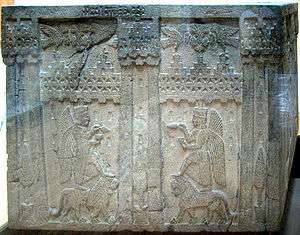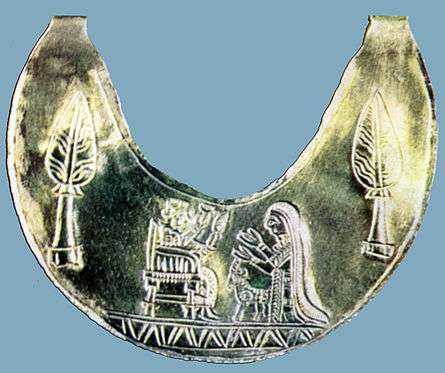Ḫaldi
| Ḫaldi | |
|---|---|
| Supreme and war god | |
|
| |
| Other names | Khaldi |
| Affiliation | Urartian mythology, Theispas, Shivini |
| Abode | Urartu |
| Symbol | Lion |
| Personal information | |
| Children | Ardinis (?)[1] |

Reign of King Rusa II (685–645 BC); Urartu; Museum of Anatolian Civilizations, Ankara, Turkey
| Mythology |
|---|
| See also |
| List of mythologies |
Ḫaldi (![]()
The other two chief deities were Theispas of Kumenu, and Shivini of Tushpa.[2]
Of all the gods of the Urartian pantheon, the most inscriptions are dedicated to Ḫaldi. His wife was the goddess Arubani. He was portrayed as a man with or without wings, standing on a lion.[3]
Ḫaldi was a warrior god to whom the kings of Urartu would pray for victories in battle. The temples dedicated to Khaldi were adorned with weapons such as swords, spears, bows and arrows, and shields hung from the walls and were sometimes known as "the house of weapons".
Some sources claim that the legendary patriarch and founder of the Armenian nation, Hayk, is derived from Ḫaldi.[4]
Gallery
 Khaldi's temple in Erebuni, 782 B.C.
Khaldi's temple in Erebuni, 782 B.C.



.jpg)

.jpg)

References
- ↑ "Armenia (Vannic)" by A.H. Sayce, p. 793-4; "Armenia (Zoroastrian)", by M(ardiros). H. Ananikian, p. 794-802; in Encyclopædia of Religion and Ethics, ed. James Hastings, vol. 1, 1908
- ↑ Ernest René Lacheman, Martha A. Morrison, David I. Owen, General studies and excavations at Nuzi 9/1, 1987, ISBN 978-0-931464-08-9, pp. 50f.
- ↑ "Haldi | ancient god". Encyclopædia Britannica. Retrieved 2015-11-25.
- ↑ The heritage of Armenian literature. Hacikyan, A. J. (Agop Jack), 1931-, Basmajian, Gabriel., Franchuk, Edward S., Ouzounian, Nourhan. Detroit: Wayne State University Press. 2000–2005. p. 65. ISBN 0814328156. OCLC 42477084.
Hayk, the legendary archer, has been part of Armenian culture and history since time immemorial. He was the primary god of the most prominent group of Urartian tribes, which eventually evolved into the Armenian nation. Hayk is considered the patriarch of the Armenians, and is indeed for this reason that Armenians call themselves Hay (pronounced haï). Hayk derives from the Urartian deity Khaldi, whose divide attributes he originally assumed with the constellation Orion. The well-known epic of Hayk's fight against Bell provides substantial proof that Hayk and his people stood up against Bel and halted the unrestrained influx of Semitic peoples from the south.
- Piotrovsky, Boris B. (1969) The Ancient Civilization of Urartu: An Archaeological Adventure. Cowles Book Co. ISBN 0-214-66793-6